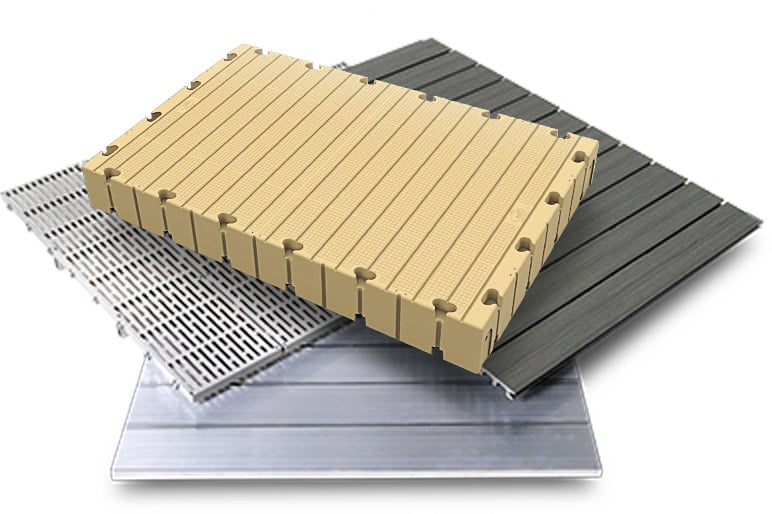Types of Docks Explained: Which is Right for You?
A safe, secure dock is a must for any waterfront property owner who wants to make the most of their shoreline. But docks can serve much more than a functional purpose — there are plenty of attractive, modular dock options that look great and enable adjustments to meet your changing needs. Read on to determine which kind of dock is ideal for your unique waterfront.
Determining Your Dock Needs: Key Considerations
Benefits of Owning Your Own Dock
Types of Docks
Floating Docks
Pile Driven Docks
Rolling Docks
Crib Docks
Suspension Docks
Dock Types for Commercial Applications
Dock Materials
Additional Dock Accessory & Part Considerations
Tips for Selecting a Dock
FAQs About Dock Types
Determining Your Dock Needs: Key Considerations
As with any important purchase, there are a series of key factors to consider before choosing a dock product. Below is a list of things you’ll need to know as you start your search.
Shoreline Characteristics:
- What type of shoreline do you have? Is it a steep drop-off or gradual slope?
- What are the conditions on the bottom? Is it sandy, silty, or rocky?
- What is the max water depth at the proposed dock location?
- Freshwater or saltwater?
- Is the waterway tidal? How much fluctuation occurs?
- What are the surface conditions of the water? Is it choppy or calm?
Dock Usage:
- What will you be using your dock for?
- How many watercrafts will the dock need to accommodate at once? (ex. Boats, kayaks, personal watercraft like Jet Skis, etc.)
- Are you looking to create a recreational space or just get on and off a watercraft?
- Do you need to remove your dock seasonally?
- Will your dock be exposed to ice if the water surface freezes?
- Do you have storage space for your dock off-season?
- What accessories will you need, depending on your usage?
- Will you need a modular option, which gives you the ability to change the layout of your dock?
Purchase & Installation:
- What is your budget?
- How much time and money are you willing to spend on maintaining the dock?
- Would you prefer to handle installation yourself, or would you prefer that someone else handle it?
Even though this may be years in the future, consider the next owner of your property. Will having a permanent dock affect your ability to sell? While a dock may increase your property value, a removable model will give the next owners flexibility.
Also — and this is important — be sure you are familiar with the local and state regulations governing dock installation and usage. Your area may have rules preventing types of docks that disturb wildlife or the shoreline sediment, and other types may require multiple permits. It’s better to find out you can’t install a certain type of dock before you get attached to one.
Benefits of Owning Your Own Dock
Owning your own dock shares a lot of similarities with owning your own home — without the cost of a mortgage. Besides not having to share or rent limited space, the benefits of dock ownership include:
- Convenient, anytime access to the water
- The ability to personalize construction, layout, and accessories
- Starting and ending your boating season on your own schedule
- Easy water access for leisure activities like swimming, fishing, and kayaking
- Creating an on-the-water living space for relaxing and entertaining
- Increased property value
With that, let’s dive into the types of docks available to residential property owners.
Types of Docks
Newcomers to the dock market may be surprised to learn that there are more options than simply wood or aluminum docks. Within the basic categories of permanent and removable docks, there are variations that account for materials, specific use case, adaptability, and more.
Before we get into the details, let’s define the two most basic dock types:
Permanent docks: These docks feature pilings (buried poles) or a concrete base embedded securely into the ground at the shoreline and are not intended to be removed. Installing a permanent dock requires extensive permitting.
Removable docks: While some docks designed to be removable may never actually be moved, having the option provides flexibility. Removable docks may be floating, rolling, and/or modular, meaning they can be expanded or modified as necessary.
Now we’ll break these basic categories down further:
Floating Docks
Floating docks can be made of plastic, aluminum, concrete, or wood; depending on the density of their decking material, they feature air- or foam-filled flotation drums that are designed to displace water and keep them afloat. They often have metal or plastic hoops around the edges, which loop around pilings while allowing the dock to move up and down with the water level. Floating docks can moored by using engineered anchors or physcial weight.
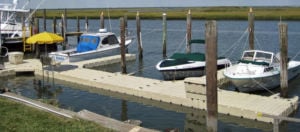
- Applications / use cases: Floating docks are a great choice for waterfront residents that need to remove docks seasonally, or who live beside relatively calm waters. Floating docks can accommodate any type of watercraft or aquatic activity, including boating, swimming, and kayaking.
- Ideal water conditions: Floating docks can easily accommodate deep or fluctuating water levels, since the depth of the water does not affect the usability of the dock. While high-quality floating docks can be quite stable, calm waters without heavy boat traffic provide ideal conditions for use.
- Ideal shoreline conditions: Shorelines or waterfronts that are unable to support a stationary dock can often accommodate floating docks. That said, a solid shoreline and bottom provide the most stable anchoring conditions for a floating dock; firm soil, or hard-packed sand is best.
- Benefits & drawbacks: Removable, and durable, floating docks provide flexibility for the seasonal dock user, prevent damage to sediment, and do not require many (if any) permits. However, while some models are exceptionally stable, floating docks are not ideal for those who desire zero movement when in use.
A type of stationary dock, pile driven docks are secured in place by wooden or metal poles called pilings, which are driven deep into the ground below the dock. Sometimes, instead of being buried, pilings can feature wide mud pads at their base that rest on the bottom and prevent them from sinking into soft sediment.
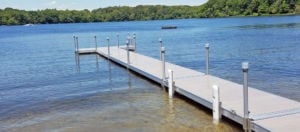
- Applications / use cases: Pile driven docks are meant to be permanent, so they are ideal for owners who do not foresee altering their waterfront access anytime soon. These docks can accommodate any type of watercraft, from lightweight personal kayaks to large fishing vessels. Seasonal stationary docks are sold in standardized sizes and are designed to be installed each spring and removed in the fall.
- Ideal water conditions: With the right protection, stationary docks with pilings can withstand most water conditions, from choppy to tidal to calm. However, be sure to factor in the maximum water depth at your location so your dock does not become submerged at high tide.
- Ideal shoreline conditions: As a general rule, pile driven docks require firmer ground than floating docks, since they rely on the sediment density for their stability. Hard-packed earth with rocks is best, since loose sand or silt may cause pilings to shift or sink.
- Benefits & drawbacks: Pile driven docks provide maximum stability for both you and your watercraft. Seasonal stationary docks are lightweight, easy to install. They work best in water depths under 8ft and in bodies of water with less than 2ft. ff water fluctuation.
Often made of lightweight aluminum, rolling docks feature a set of plastic wheels that makes removal and installation a breeze.
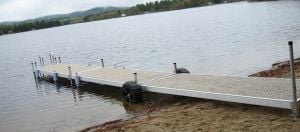
- Applications / use cases: Rolling docks combine the flexibility of floating docks with the stability of pile driven docks. They can accommodate most types of watercraft and aquatic activities, and can be easily removed for seasonal storage or maintenance, provided there is enough room for them to roll up onto the shore.
- Ideal water conditions: Their stability makes rolling docks well-suited to both calm and choppy waters.
- Ideal shoreline conditions: Firm shorelines with a low grade and minimal rocks or debris are best for rolling docks. Steep, rocky, or soft shorelines can make it difficult to install or remove rolling docks. Also, some shorelines may not be large enough to store the dock once it is out of the water.
- Benefits & drawbacks: Rolling docks are incredibly versatile and offer an easy solution for seasonal waterfront use. They are often light enough for owners to handle installation and removal themselves. However, rolling docks are not compatible with all shoreline conditions, particularly rocky or soft ground.
A crib dock consists of decking placed on top of a wooden or aluminum frame or crate filled with large rocks. They are meant to be stationary and permanent.
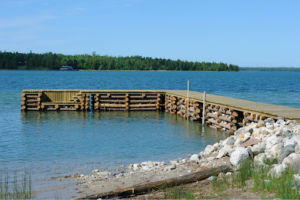
- Applications / use cases: Crib docks essentially extend the shoreline, offering a stable place to dock boats and additional waterfront space for recreation, entertaining, and relaxing.
- Ideal water conditions: Crib docks can withstand most water conditions, including choppy waves, strong currents, or frequent storms.
- Ideal shoreline conditions: Since they are incredibly heavy, crib docks need firm ground to stand on. Occasionally, if the shoreline is made of soft sand or features a steep slope, the entrance to a crib dock will need to be supported by a pile of large rocks.
- Benefits & drawbacks: Crib docks offer stability and longevity, and can withstand heavy use and rough conditions. However, due to their size and bulk, they can disrupt water flow and nearby wildlife.
Suspension docks hang over the surface of the water from cables attached to earthbound pilings or a waterside building.

- Applications / use cases: Suspension docks make for attractive recreational or living spaces, and can accommodate watercraft in areas that don’t experience depth fluctuation. Some models (called lift-up docks) can be raised out of the water like a drawbridge when not in use.
- Ideal water conditions: If using suspension docks to launch and dock watercraft, fresh or non-tidal water is recommended. Otherwise, if the water level drops too low or too high, the dock will become inaccessible by boat.
- Ideal shoreline conditions: Since they are anchored from above, suspension docks need to be installed in front of a building or at a shoreline that can accommodate deep pilings and considerable weight.
- Benefits & drawbacks: Suspension docks are unique, attractive, and provide an innovative locale for outdoor dining or waterfront relaxing. They also make less of an impact on the surrounding environment than pile driven docks. However, they may be more susceptible to damage in stormy weather, since they cannot move with the water level. The engineering and equipment involved in their installation can also raise the price significantly.
Dock Types for Commercial Applications
Chances are, if you are a commercial property owner, you’re not here to learn about caissons or graving docks — massive structures used in freight locks and for dry docking multi-ton watercraft. However, if you own a small to midsize marina or fishing operation, you may want to consider aluminum or plastic docks for commercial projects.
Aluminum docks — either floating, rolling, or stationary — are an attractive, low-maintenance option for busy communal docks, especially those in frequent use by boat owners, charter companies, or small to midscale fishing operations. Despite the coming and going of many feet and the debris that comes with marine recreation, aluminum docks can easily be hosed down or washed with mild soap to be returned to their original shine.
Likewise, plastic docks for commercial applications are lightweight and easy to care for, especially for seasonal use. Plastic kayak launches offer the ideal solution for kayak or PWC rental companies, since they provide renters with a safe way to cast off and land.
Other docks for commercial use include those made from concrete, or those with high freeboards.
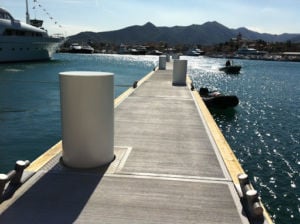
Concrete docks feature either a solid block of concrete resting on the bottom of a body of water, or a slab of concrete decking supported by concrete pilings. They are designed for heavy-duty industrial applications, just as freight shipping, but are also recommended for waterways that experience frequent storms or turbulent currents.
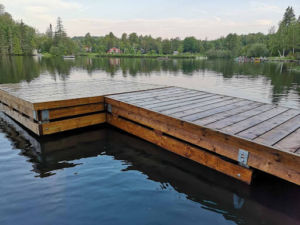
Docks with high freeboards, or the amount of height between the decking and the waterline, are better suited to larger watercraft such as schooners or freighters — anything that requires a gangway for boarding or disembarking. High freeboards are not recommended for recreational use, since swimmers and boaters alike may have difficulty moving safely between the water and the dock.
Dock Materials
Whether you choose aluminum, plastic or classic wooden docks, it’s imperative that the dock materials are of high quality. Not only will quality ensure safety and longevity, but the ideal dock material will be low maintenance, weather resistant, and gentle on bare feet. Fortunately, there are high quality docks out there that don’t sacrifice looks for functionality; today’s practical, durable dock solutions can be quite attractive. Whatever you choose, be sure to consider both the short- and long-term benefits of your desired material.
Dock Materials Comparison
| Aluminum | Plastic | Wood | Steel | Composite Decking | Concrete | |
| Applications | Residential, Industrial, Light Commercial, Industrial | Residential, Industrial, Light Commercial, Industrial | Residential, Marina | Commercial, Industrial | Residential, Marina, Public access | Commercial, Industrial |
| Water conditions | Fresh & saltwater (aluminum will oxidize over time in saltwater) | Fresh & saltwater | Fresh & saltwater | Fresh & saltwater; rough waters | Fresh & saltwater | Fresh & saltwater; rough waters |
| Benefits | Lightweight, Durable, Comfortable, Maintenance Free | Lightweight, durable, comfortable, Maintenance Free | Durable (if treated) | Durable, Strength | Durable, Comfortable | Durable, Strength |
| Drawbacks | May oxidize in saltwater | Heavy, Environmental impact, Splinters | Heavy, Corrosive | Disruptive to environment | ||
| Average cost | $$ | $$ | $ | $ | $$ | $$$ |
| Upkeep requirements | Minimal buffing & scrubbing w/ soap & water | Scrubbing w/ soap & water | Sanding, Sealing, Replacing rotted boards | Corrosive | Scrubbing w/ soap & water | Power-washing |
| Durability(out of 10) | 9/10 | 9/10 | 6/10 | 8/10 | 8/10 | 10/10 |
| Environmental considerations | Pile driven docks may disrupt sediment | Recyclable; not 100% ice-resistant | Pressure-treated wood can contaminate waterways; pile driven docks may disrupt sediment | Pile driven docks may disrupt sediment | Can disrupt water flow & wildlife; can withstand storms and choppy waters | |
| Safety hazards | Can overheat in direct sun w/out decking ventilation | Splinters | Can overheat in direct sun w/out decking ventilation | Extremely hard surface |
Additional Dock Accessory & Part Considerations
The dock itself may be the star of the show, but dock accessories and parts play major supporting roles when it comes to installation and ideal use.
Aluminum Gangways and Poly Ramps: These ramps provide a stable bridge between the shore and your dock. Aluminum gangways are the traditional choice, while poly ramps offer a lighter alternative. Gangways and ramps are recommended where the water level is far lower than the shoreline, or where the water level fluctuates, since the ramp adjusts as the dock raises or lowers.
Swim Floats: These are floating platforms anchored to the bottom of a body of water, often separate from a main dock system. Great fun for swimmers of all ages, they can be customized with ladders, slides, or slips for kayaks or other personal watercraft (PWC).
JetSki Lifts: These add-ons make docking and launching easy for almost any PWC user. Shaped like a shallow trough with wheels embedded in the bottom, some varieties can attach securely, via puzzle teeth or hardware, to an existing dock.
Boat Lifts: With a similar design to a JetSki lift, these add-ons allow users to easily dock and launch small to midsize watercraft. They provide a safe storage option for boats in inclement weather.
Kayak Launch: Stable and secure, this accessory “cradles” your kayak as you board or disembark, preventing any tipping accidents.
Low Profile Rowing Dock: With a low-slung freeboard that barely extends above the waterline, rowing docks are perfect for kayakers or rowing crews.
Stairs/Ladder: Stairs or ladders leading from the dock into the water make it much easier to get in and out of a boat or the water.
Additional Hardware & Accessories: Most boating docks will require hardware like cleats, pipe brackets, lights, and bumpers, which come at an additional cost to the dock system. Other nice-to-have accessories include bench kits, mooring whips, kayak racks, and other add-ons that make dock usage more convenient.
Tips for Selecting a Dock
As you embark on your dock selection process, it helps to do a bit of research before speaking to a dock specialist. That way, you’ll be able to determine which of their recommendations will work best for you.
First and foremost, consider the type of shoreline, water depth, bottom conditions, and surface conditions at your waterfront; consult the Types of Docks section above to identify the best style for your property. Other key factors for residential dock owners to consider include:
- Dock weight, if installing or removing the dock yourself
- The dock’s effect on your property value
- Space and ability to move and store your dock off-season
- Longevity of dock materials
- Comfort and durability of decking materials
- The importance of aesthetics
- Your budget
- Your time and ability to maintain the dock
- Customer reviews of recommended products
- The environmental impact of dock structures and materials
- The number and type of watercraft that will tie up at the dock
- The potential need for dock customization or expansion
Make sure you clear your preferred type of dock with local and state regulatory bodies, especially for stationary or permanent docks. You don’t want to settle on the dock of your dreams, only to be told it’s not compatible with area regulations.
To make this discovery phase easier for would-be dock owners, FWM Docks offers a Dock Selector tool that accounts for water depth, bottom conditions, and shoreline qualities, then generates the ideal type of dock. Try it out for yourself here:
FAQs About Dock Types
What kind of dock is best for saltwater?
Most high quality dock materials will be durable in both fresh and saltwater.
How long do aluminum docks last?
If regularly maintained, aluminum docks will last for decades, especially when installed in calm waters. Prolonged stormy or turbulent conditions may negatively impact the lifespan of any dock
Are plastic docks bad for the environment?
No, plastic docks are safe for the environment. They are 100% recyclable, and some dock manufacturers will even use recycled materials to build their plastic docks.
What if I need to reconfigure my dock?
FWM Docks specializes in modular dock systems that owners can customize to their hearts’ content. Once one of our Aluminum or EZ Dock systems is installed, our customers have the option to expand, reconfigure, or augment their dock layout.
Try Our Dock Selector
Find the Right Dock with FWM Docks
Now that you’re equipped with all the necessary information, you’re one step closer to finding your perfect dock. If you’re unsure of that next step, or if you have any questions following your test drive with our Dock Selector, reach out to an FWM Dock Specialist today. With nearly 50 years of experience in the dock industry, we’re always ready and happy to help.
